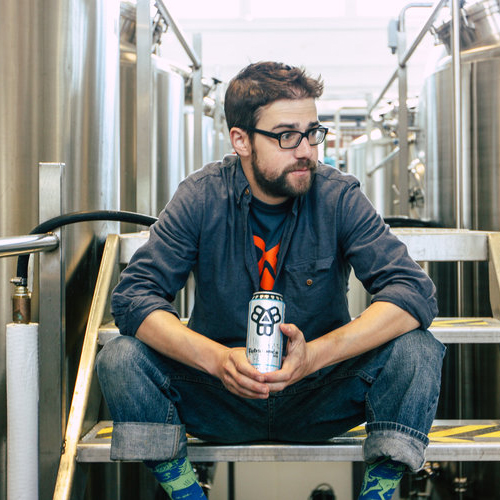Sante Adairius Rustic Ales (known as “SARA” on the west coast) is a unique little brewery. Adair Paterno (her name weaved its way in to the name of the brewery) opened the business with her then-life-partner Tim Clifford in May 2012, and some things have changed. You can’t stroll in with outside bottles of beer anymore, expecting to open them up and share them in the tasting room like before. And the brewery and tasting room have both since expanded. But some things haven’t changed. The beer is phenomenal, and the folks behind it — still Adair and Tim, working together — are incredible people to be around. SARA’s tagline is “Know Your Brewer” — a simple enough notion for a small craft brewery built around two distinct individuals. But now in their third year, and with so many successes and challenges behind and ahead, it seemed like it was time once again to get to know Adair.
Photo by Kyle Kastranec for GBH

To me, Sante Adairius is a brewery with inspiration. It’s got a unique character that makes it a place I want to visit and drink. What was that initial inspiration?

To be honest, we didn’t have a grand goal in mind. The brewery was a dream that Tim and I had. We saw a real need in this area for the beers that we wanted to drink. Tart, funky saisons in addition to hop-forward IPAs. We were, and still are, enamored by the saison style. At the time, Tim had gained a lot of notoriety in some homebrew competitions, especially with beers in Category 16e—Belgian Specialty Ale. We opened up the brewery on that reputation, and our love for flavorful beers. Interestingly enough, the BJCP got rid of that category in the new guideline revisions. It no longer exists.

How important is that category to what you’re brewing?

We want to add to the tradition of saison making. But first and foremost, we are a homebrewers' brewery. We have a piece of equipment from Lipton that we turned into a kettle and we have a bunch of used dairy tanks hanging around. We batch sparge, and we use the same hoses and equipment for our “clean” and “funky” beers. But we really don’t need all of our beers to be “shelf stable.” I'm not packaging a clean, hoppy beer that needs to be consistent three months down the line when someone buys it at a liquor store. We do brew those beer styles too, but those beers are getting tapped and enjoyed and then they are gone in about two weeks. If you plated them up, sure, there might be some Brett, but that doesn't have any affect on the overall type of beers that we are brewing.

When I visited about six months ago, I remember seeing your house cultures just out there in the back. Everything, even your clean hoppy beers and your porter, had a distinct character. Certainly the bottled funky stuff — West Ashley, Saison Bernice, beers from the 16e series — all have a house character.

Well, when it comes to the funky beers, those are typically always a little different, and we are in a sense very dependent on our yeast and microbacteria. Our mixed-house culture has really taken root; it’s just an amazing yeast culture. Our beer gets funky in 3-4 months, with tart-y flavor profiles. We haven’t had many challenges to create the flavor profiles we want. It starts with awesome yeast and bugs.

Is that what you mean by “rustic,” then? The brewery itself is basically an industrial complex off the side of the highway in Capitola (Santa Cruz).

Yeah, so we tend to shy away from throwing out that term, “farmhouse.” It’s disingenuous to the folks that have an actual farmhouse brewery, like Shaun out at Hill Farmstead or the guys out at Jester King. We joke that we brew “rustic industrial park ales.” To us, rustic is more of a style, an idea of what it means to brew beer in the historical or the traditional way. It’s about what beer tasted like before everything was industrialized. That circles back to the equipment that we use and the house cultures that we brew with.

I think that there are an increasing number of breweries that are driving their beer with yeast. We’re also seeing small yeast producers pop up — not your White Labs or Wyeast, I’m talking about companies like Gigayeast or the Yeast Bay. As the science of yeast continues to develop, do you think we will see a change in the rustic or wild side of beers?

Certainly. I think that brewers are becoming more savvy. Maybe that’s not the right word. But more experimental with the ways that they are harnessing yeast. Yeast is living, evolving. There’s no way we have harnessed all the potential yeast that can make great beer. There’s got to be so much more that we can do with flavor. Just like sourdough bread, there’s so much complexity and yeast character. Then, you’ve got the trend of spontaneous fermentation, with breweries like Allagash and Jester King and De Garde. These beers that are spontaneously fermented are absolutely harnessing the house character of "wild" yeast.

For a yeast-driven brewery, a lot of your identify and distinction is wrapped up in the flavors and aromas you derive from your house cultures. And we see styles like saison and farmhouse being attempted in a variety of ways, and with a range of commitment to the truth of the style. Some people just want to take shortcuts and propagate someone else’s yeast and be done with it. Do you see that happening?

For sure. There was this one guy who recently emailed us — he heard Tim on a podcast mention that we have our mixed cultures banked at GigaYeast just in case we ever needed to use it. He thought that he could go ahead and buy it from them and wanted to make sure we were okay with that before he went ahead and did it. Of course, that’s not the case. We said no, you can’t do that, but that you can probably get bottle dregs from our bottles and get the same results. We’re seeing a lot of breweries borrowing cultures from one another, and there’s a risk that you’re going to end up with very similar flavor profiles as a result if breweries are just dropping these dregs into their own beers without making any changes to it. That would be unfortunate. If people are playing with cultures, adding to them, that’s how you develop new flavors in yeast.
We encourage people to work with our yeast. If you look at commercial breweries that use the same commercial strains of yeast, they get different results based on their technique, their brewing system, their water, so I’m not too concerned that there's another place that will take our house flavor away. But it would be unfortunate if people stopped being inventive with yeast and bacteria. Our culture comes from years and years and years of collecting different bottle dregs, and building them up, and tasting them, selecting for things we like. I’d hope that people continue to do that rather than just try to make funky beers by buying a commercial strain.

With brewers banking their yeast at these labs, is there a risk that they could be tweaked and commercialized under a different name? Is there anything keeping your bank from creating, say, a "Monterey Bay Farmhouse" strain and selling it to brewers across the country? What’s to stop them if there’s a demand for it?

That’s a good question. We don’t have a contract. We have our culture at GigaYeast, which is a very small lab in the Bay Area, and we were one of his very, very first customers. And as a result, he’s very good to us. And despite that fact that I’m a lawyer, we don’t have a contract. I’m very comfortable that he would not sell it to anybody without talking to us first, or wouldn’t tweak it and sell it as his own thing. I just sort of have faith. But I have no idea what happens at other labs — we don’t have anything banked there. The only thing we buy is one Brett strain from Wyeast, and everything else we buy through GigaYeast.
We’ve always wanted to be open about everything. The only reason we can make these beers is because people like Vinnie Cilurzo and Tomme Arthur, way back when, would be so open about their technique. I remember when Tim was a homebrewer and Vinnie was giving out wood chips with his bugs in them. That’s probably still part of our culture. So yeah, we want to stay open about it, but we don’t want people to just copy it directly.

There’s also a difference between you developing and cultivating a relationship with someone like Vinnie and them sharing their knowledge and assets with a person he knows and likes, and he knows they’ll be treated well. Versus someone who’d rather just click on a website and order a packet to their door and then: “Sweet, now I’ve got Sante Adairius cultures.” There’ isn’t always a lot of respect or even acknowledgement around the industry for how widespread the Dupont Saison strain has become. That’s a world-famous saison that still sells in the States, and it’s competing with thousands of other breweries now using a commercialized version of their yeast.

Oh, for sure, even us. A lot of our saisons, before we add our house culture, we ferment them with a blend of saison yeast, which is essentially a Dupont and a Belgian-French strain. Everyone’s fermenting with the same commercial Belgian yeast, even though there’s really no such thing. Belgian yeast is just whatever’s floating around in the air over there.

You have a couple different versions of a so-called “house culture” here — both the yeast and the taproom itself. I remember when I visited awhile back, it was like one big bottle-share. People had Alpine bottles out, bottles from Cantillon. I was really surprised to see that.

Yeah, that went away. We had concerns on a number of levels, legality first and foremost. But people actually started bringing in coolers, trying to one-up and outdo each other with the beers they were bringing in. Part of me misses it. We had a really great Tuesday group that would meet up to share beer. I got to drink and taste a lot of awesome beers. We didn’t always have that much of our own beer on tap early on, but that’s changed now too. We’ve had people who thank us for getting rid of the bottle sharing aspect to the tasting room because it made some people feel like they were left out — like it was some sort of club that they weren’t a part of. We very much want to maintain an inclusive, community vibe in our tasting room.

But you do offer also offer a club — you have a Cellar Society, a beer membership program. You aren’t concerned about creating a sense of exclusivity surrounding your beers in that way?

It’s not intended to be an exclusive club in that way, but it's a way to show some love for the locals. Our club is open by invitation only, so we have to personally know you in order for you to be a part of this. Again, it’s only really for people who have supported us for a long time. Plus or minus 300 people total. It’s a way for friends and family of the brewery to guarantee that they can get access to the beers that we bottle. It’s a thank you for the support.

Who is this group of locals? Who are the folks who are coming in to SARA to drink on a regular basis?

Yeah, it's a local group of people mostly, about a 45-minutes radius around the brewery. People from Santa Cruz, San Jose. People who care about beer. We are not easy to find, you can't just stumble upon us. I am a beer geek and these people are part of my tribe. But in a sense, we'd love some more exposure. I don't have to explain what a saison is to these folks, but then I do also miss out on the opportunity to educate someone about what saison is. We are thinking about opening a tasting room that is more accessibly located closer to downtown Capitola, but part of that decision comes down to the risk of the atmosphere that we have cultivated in the tasting room at our current location. We don't want to change things too much.

Has the motivation behind SARA changed at all since you opened up?

Tim and I still share the same motivation behind beer and the beer industry. We've had our ups and downs, but at the end of the day we started this as a family project and we are carrying that through, taking care of the 7 employees that we have. We are all passionate about our beer and our community. We all want to keep the tribe together, whether that means brewing 3 or 10 or 1,000 barrels at a time.

Let’s talk about transitions and partnerships, since I know you went through a major personal shift early on with Tim. You were life partners, and then you weren’t, and you still had a brewery to run where you were both very hands-on and managed things in a personal way. How did you manage to keep the focus on the beer, the brewery, and the people who work there through that?

We were together for about 20 years. You both have to have a real commitment to the beer and the business. If you don’t then there’s absolutely no way it’s going to work. It’s extremely difficult to be in any business partnership, whether you’re friends or romantic partners. And you have to stay committed to your employees. We have this great staff that's like family now and I feel a responsibility for them. We make sure they have health insurance and can pay their rent every month. If we were childish and let our personal issues get between us, it wouldn't just be hurting us, it would be hurting our customers, the business and most importantly our employees. So we try to keep our personal stuff out of it, and that doesn’t always happen, but we do our very best. And Tim would say the same thing — we just both have a real commitment to the business and it’s grown exponentially since we split up romantically and just became business partners.

That must have been an anxious moment as an employee, wondering what would happen to the business, or knowing that it was happening at all. Small businesses are so personal that way. It’s not like there’s layers of hierarchy and board members or shareholders to ensure things stay on track. It’s just you and your employees. How did you ensure they were confident in the future?

We sat down and had a meeting and told them that no one was going to leave, and no one would lose their job. And thankfully, I didn’t lose one employee. They felt confident in the brewery itself, I think. And our employees are just as committed as we are. You don’t get to say that in a lot of businesses. They all feel a sense of ownership and pride in the beer that comes out of here, in each other, and our relationship with the community here, and on a larger scale. That was a big part of it, they’re just so committed.
I think we give people a lot of freedom. We gave them health insurance before we even started paying ourselves. We cover 100% of the premiums. It was important to us to keep good people around by paying them the best we could pay them with a living wage. We did that before we could really afford it, and certainly before we paid ourselves. I think they knew we made sacrifices for them, and honestly, I just think they really like the beer! They’re part of something. This little community we’ve created in this industrial park is just amazing.

What else, besides the beer and the community, really motivates you?

One of the most exciting things for me is being on the front lines of the legislative process with the California Craft Brewers Association. It's all about defending the rights of beer manufacturers and continuing to further those rights. I love using my legal background and my legal skillset to get involved and contribute to the CCBA's legislative work. The leverage that the beer distributors has is tough, they have a strong lobby, very politically savvy, and as manufacturers we all need to move forward together to protect the rights that we have.
Beer people are the best people, and it's great to be a part of this growing group of folks. It's also extremely exciting to get to know the "big guys" in beer through the CCBA. These are people that I look up to and feel that I can turn to for advice — people like Natalie Cilurzo, David Walker, Joyce Turner, Brian Hunt, and so on.

Last week you met with Cory and Karen King of Side Project in the tasting room, someone who’s venturing into similar territory as Sante Adairius. Does Cory live up to the hype?

He and Karen are so great. I raced back from my camping trip because I wanted to hang out with them here. They are just such a joy to see, because they’re just so sweet and fun. All these Midwestern people, I swear. The nicest people to be around.










